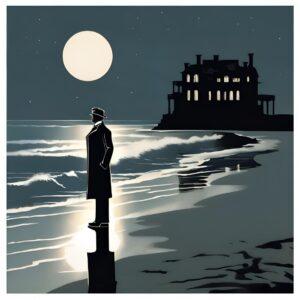When a monumental dream shatters, what desolate truths surface in the wreckage, and how is its tragic loss ultimately understood
Following the tragic deaths in Chapter 8, F. Scott Fitzgerald’s The Great Gatsby reaches its sorrowful conclusion in Chapter 9.
Narrator Nick Carraway, writing two years later, recounts the desolate aftermath, his solitary efforts to manage Gatsby’s affairs, and his ultimate, searing judgments on the characters and the morally hollow society they inhabited.
As Nick navigates the fallout and prepares to retreat from the East, you witness his disillusionment and his crucial role in shaping Gatsby’s enduring legacy against a pervasive indifference and careless corruption.
“First, a concise chronological summary recaps Chapter 9’s key events. Our subsequent analysis argues that Fitzgerald uses Nick’s final acts and reflections to deliver a scathing indictment of the Eastern elite’s moral bankruptcy.
Through Nick, the chapter offers a profound meditation on the American Dream, the inescapable past, and the human struggle against forces pulling us backward, framing his retreat as a moral necessity.
(For context on Gatsby’s death and the preceding events, see the Chapter 8 Summary & Analysis.)

The Great Gatsby Chapter 9 Summary
The final chapter opens with Nick Carraway, two years after Gatsby’s death, recounting the desolate days immediately following the tragedy and his eventual departure from the East.
The Aftermath: Rumors and Responsibilities
In the days following Gatsby’s murder, his mansion is besieged by police, reporters, and curious onlookers, fueling “wild, untrue stories” about Gatsby, Myrtle, and Wilson. Nick, finding himself “on Gatsby’s side, and alone,” assumes the solitary responsibility for handling Gatsby’s affairs and arranging a dignified funeral, as no one with a genuine connection steps forward.
Futile Attempts to Gather Mourners
Nick’s efforts to contact Daisy and Tom Buchanan reveal they’ve “gone away…leaving no address.” His attempts to reach Meyer Wolfsheim, including a visit to his office, are initially met with evasion; Wolfsheim eventually sends a letter expressing shock but callously stating he cannot get “mixed up” in the funeral.
Klipspringer, “the boarder,” calls, but is concerned only with retrieving a pair of tennis shoes, declining to attend the funeral due to a conflicting “picnic.”
The Arrival of Henry C. Gatz
Three days after Gatsby’s death, Nick receives a telegram from Henry C. Gatz, Gatsby’s estranged father, who travels from Minnesota. Mr. Gatz, an old, poor, and visibly grief-stricken man, expresses immense, naive pride in his son’s material success.
He shares with Nick a worn photograph of Gatsby’s house and Gatsby’s childhood copy of “Hopalong Cassidy,” inside which a young James Gatz had meticulously written a detailed schedule for self-improvement and a list of “General Resolves,” revealing early ambitions.
A Sparse Funeral
Gatsby’s funeral is sparsely attended. Only Nick, Mr. Gatz, a few of Gatsby’s former servants, and, to Nick’s surprise, “Owl Eyes”, the man he had encountered in Gatsby’s library in Chapter 3, brave the rainy weather. As they leave the cemetery, Owl Eyes offers a poignant, pitying remark: “The poor son-of-a-bitch.”
Nick’s Decision and Farewells
Feeling the East has become “haunted” and morally distorted for him following the summer’s tragic events, Nick decides to return to his home in the Midwest. Before leaving, he meets with Jordan Baker to formally end their relationship. Jordan, coolly claiming sh’is engaged to another man, accuses Nick of not being “a little careful” himself, implying his own dishonesty.
Final Encounter with Tom
One afternoon in late October, just before his departure, Nick encounters Tom Buchanan on Fifth Avenue. Nick initially refuses to shake Tom’s hand.
Tom, unapologetic, reveals he was the one who told George Wilson that Gatsby owned the yellow car that killed Myrtle. He justifies his actions as self-preservation, claiming Gatsby “had it coming to him,” and expresses self-pity for his own “suffering” in the affair.
Nick concludes that Tom and Daisy are “careless people” who “smashed up things and creatures and then retreated back into their money or their vast carelessness.” He finally shakes Tom’s hand, feeling like interacting with an incorrigible child.
Last Night in West Egg: Erasing the Obscenity
On his final night in West Egg, Nick walks over to Gatsby’s now-empty and desolate mansion. He finds an obscene word scrawled on the white steps by some boy with a piece of brick and erases it with his shoe, a final act of preserving some dignity for Gatsby’s memory.
Meditations on the Shore: The Green Light and the Past
Nick lies on Gatsby’s beach, looking out at the Sound. He reflects on Long Island’s history, imagining it as the “fresh, green breast of the new world” as seen by the first Dutch sailors. He connects this pristine vision to Gatsby’s initial wonder when he first identifies Daisy’s green light across the bay, symbolizing his belief in the “orgastic future.”
Nick concludes the novel with his famous lines: “So we beat on, boats against the current, borne back ceaselessly into the past.”
Chapter 9 Analysis: Nick’s Final Reckoning – Shaping Gatsby’s Legacy and Condemning a Careless World as He Retreats from the Corrupted East
More than a mere epilogue, Chapter 9 is Nick Carraway’s moral and narrative reckoning. As he ties up the summer’s tragic loose ends, he simultaneously shapes Gatsby’s legacy and delivers his ultimate judgment on the society that both created and destroyed him.
The Narrator as Executor: Nick’s Burden of Responsibility
In the vacuum left by Gatsby’s death and the swift, indifferent departure of those who populated his parties, Nick Carraway assumes the solitary responsibility of managing Gatsby’s affairs. His poignant statement, “I found myself on Gatsby’s side, and alone,” reveals his evolving loyalty and a deep-seated moral imperative.
His determined efforts to arrange a proper funeral, despite the callous refusals from figures like Meyer Wolfsheim (who “cannot get mixed up”) and the parasitic Klipspringer (fixated only on his tennis shoes), highlight the superficiality of Gatsby’s social connections.
This self-imposed burden transforms Nick from a mere observer into the primary shaper and guardian of Gatsby’s posthumous narrative, attempting to impose a final dignity onto a life built on illusion yet fueled by infinite hope.
The Judgment of the Living: Carelessness, Callousness, and Complicity
Nick’s final encounters with Jordan Baker and Tom Buchanan crystallize his disillusionment with the Eastern elite. Jordan’s cool accusation that Nick himself was dishonest (“You said a bad driver was only safe until she met another one”) attempts to deflect her own carelessness, a charge Nick silently accepts or dismisses.
The confrontation with Tom exposes the man’s unrepentant nature; Tom’s justification for directing Wilson toward Gatsby, “He had it coming to him,” and his subsequent self-pity reveal a chilling inability to comprehend the moral consequences of his actions.
Nick’s ultimate assessment of Tom and Daisy as “careless people” who “smashed up things and creatures and then retreated back into their money or their vast carelessness” is a devastating indictment. His decision to shake Tom’s hand signifies not forgiveness, but a weary resignation to their incorrigible, child-like moral vacuity.
Gatsby’s Father & the “Hopalong Cassidy” Schedule: Echoes of a Simpler Dream
The arrival of Henry C. Gatz, Gatsby’s estranged father, introduces a poignant counterpoint to the Jazz Age’s sophisticated corruption. Mr. Gatz, old and poor, radiates a naive pride in “Jimmy’s” material success, embodying a simpler, perhaps more traditional, version of the American Dream.
The childhood copy of “Hopalong Cassidy,” with its meticulously written schedule for self-improvement (“Rise from bed… Study needed inventions… Be better to parents”), reveals the earnest, disciplined ambition of a young James Gatz.
This tangible piece of Gatsby’s authentic past contrasts with the morally ambiguous methods and grandiose persona he later adopted, suggesting an initial idealism that became tragically perverted in his obsessive pursuit of wealth and Daisy.
Owl Eyes at the Funeral: A Moment of Unlikely Witness
The surprising appearance of Owl Eyes at Gatsby’s sparse, rainy funeral offers a moment of unexpected, sober perspective. Having earlier, in drunken wonder, discovered the “realism” of Gatsby’s unread library (a “regular Belasco” stage set), he now provides a final, clear-sighted judgment.
His simple, pitying observation, “The poor son-of-a-bitch,” cuts through the layers of rumor and Gatsby’s own manufactured grandeur. It’s an unvarnished acknowledgment of Gatsby’s tragic isolation and humanity, a rare moment of genuine, if bleak, empathy from one of the few who glimpsed the artifice behind the spectacle and still chose to bear witness to its end.
Retreat to the Midwest: Nick’s Rejection of the “Distorted” East
Nick’s decision to return to the Midwest signifies his moral rejection of the East. He perceives the glittering East Coast society, particularly West Egg and East Egg, as “haunted” and fundamentally “distorted” by its pervasive materialism, moral carelessness, and rigid social stratification.
His reflection that “this has been a story of the West, after all, Tom and Gatsby, Daisy and Jordan and I, were all Westerners” suggests a belief that their shared origins perhaps rendered them “subtly unadaptable to Eastern life,” or, more damningly, that the East’s environment corrupted whatever inherent Midwestern values they might have possessed.
His nostalgic evocation of “thrilling, returning trains” and the wholesome order of his youth contrasts sharply with the “grotesque” quality he now attaches to his Eastern experiences.
Erasing the Obscenity: Shaping Gatsby’s Final Image
Nick’s act of erasing an obscene word scrawled by a boy on Gatsby’s steps before his final departure from West Egg is a small but deeply symbolic gesture. It represents his ultimate act as Gatsby’s loyal confidante and the self-appointed curator of his memory.
By “drawing my shoe raspingly along the stone” to remove the vulgar graffiti, Nick attempts to cleanse Gatsby’s public image, to protect the memory of his extraordinary dream from the world’s crude defilement.
This action mirrors his larger narrative endeavor: to tell Gatsby’s story in a way that acknowledges his flaws and illusions and preserves a sense of his “incorruptible dream’s” tragic dignity.

The “Fresh, Green Breast of the New World”: Interpreting the Final Vision
Nick’s final meditation on Gatsby’s beach elevates the novel to a profound commentary on the American Dream and the human condition. He imagines the “fresh, green breast of the new world” as it once appeared to Dutch sailors, a pristine continent “commensurate to [man’s] capacity for wonder.”
He explicitly links this historic sense of boundless, virginal possibility to Gatsby’s personal, intense wonder at Daisy’s green light, a symbol of his “orgastic future.”
However, Nick concludes that this dream, for Gatsby and perhaps for America, was already in the past, lost in the “vast obscurity beyond the city where the dark fields of the republic rolled on under the night.”
The iconic closing lines, “So we beat on, boats against the current, borne back ceaselessly into the past”, crystallize this elegiac vision. They suggest a universal human struggle, a relentless striving towards future aspirations while being irresistibly and perpetually tethered to the inescapable weight of personal and collective history.
Chapter 9: Nick’s Final Reckoning – Shaping Gatsby’s Legacy and Condemning a Careless World as He Retreats from the Corrupted East
Chapter 9 provides Nick Carraway’s ultimate moral and narrative resolution. As he meticulously manages the desolate aftermath of Gatsby’s death, he also constructs Gatsby’s enduring legacy, delivering a decisive judgment on the moral carelessness of the Jazz Age elite and the corrupted promise of the American Dream.
The sparse funeral, the indifference of former associates, and the appearance of Gatsby’s father contrast with the magnificent illusion Gatsby projected. Nick’s final encounters with Jordan and Tom solidify his disillusionment, compelling his retreat from what he perceives as the distorted, haunted East.
Nick’s concluding reflections transform Gatsby’s tragedy into a deep metaphor for the American experience, a relentless striving against the currents of the past, forever reaching for an “orgastic future” that remains tantalizingly, tragically out of grasp.
This final chapter cements Nick’s role as the crucial lens through which Gatsby’s story is understood, offering a somber meditation on dreams, reality, and the enduring quest for meaning in a morally compromised world. Revisit the entire tragic arc in the main The Great Gatsby analysis.
A Note on Page Numbers & Edition:
Just as Nick Carraway pieces together the fragments of Gatsby’s life to present a final narrative, ensuring citation accuracy requires careful attention to the specific edition used. We meticulously sourced textual references for this summary and analysis from The Great Gatsby, Scribner 2020 Paperback edition (Publication Date: September 1, 2020), ISBN-13: 978-1982149482. Always verify page numbers against your specific copy for academic integrity.
